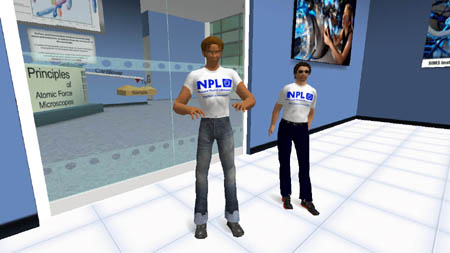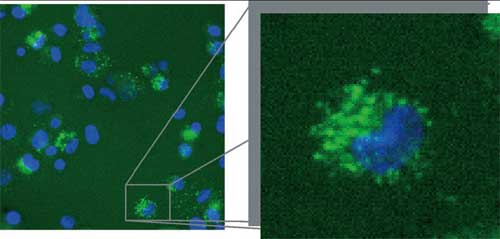Here's a freebie for you. I spent a great deal of time on this one, on and off, during the past year or so. But, for various reasons that are really too boring to go into, it never saw the light of day. I'll only say that scientists have disagreements (shocking, yet true), but they do not like them aired publicly. My role is different, however. What I do, is tell true stories.
So, here's the raw, unedited copy. Some of this you'll recognize as having been published in other work I've done, but most of it is new. Enjoy. And, if you really enjoy it, donations to my kids' diaper and daycare fund are welcome and appreciated.
By Howard Lovy
The tiny dendrimer, nanotechnology’s tendriled, tattered and almost forgotten starlet, is at last emerging from nearly 30 years of patent-filing and science-paper purgatory and into the light of real-world products and partnerships. In 2007 alone, dendrimers have attracted about a million dollars in DARPA funds for research into a device that would automatically keep wounded soldiers free from pain on the battlefield; they have come to the apparent rescue of a company that had been having trouble getting its soft-tissue cancer treatment device to stop leaking radiation; and after success as MRI contrast agents, dendrimers are now being taken seriously as a candidate for a long-sought delivery agent for siRNA (gene silencing) therapy.
And by the time the U.S. Food and Drug Administration gives its anticipated 2009 or 2010 approval to the first dendrimer-based pharmaceutical, the former Dow Chemical Co. scientist who invented his pet molecule will have counted 30 years since he first synthesized this “beautiful” (his word) molecule in his Midland, Mich., lab. But Donald Tomalia says he doesn’t mind the nearly three decades in the cold. In fact, he says, the pattern for any “disruptive” technology is to first pay its dues for about 20 years before general acceptance. “We’re kind of on schedule there when you think about it,” Tomalia says.
Yet, even though an FDA nod for the dendrimer-based HIV microbicide VivaGel would place the stamp of government validation on concepts Tomalia has worked for a generation to prove, the journey itself has ripped the dendrimer’s reputation so ragged that skepticism still prevails in the financial and scientific communities.
Long, fruitless periods of development, intellectual property quaqmires, questions over toxicity, skepticism about cost and scaleability have reduced the once-darling dendrimer to the status of merely the first of many nanotech disappointments. The years since the dendrimer’s sensational arrival have seen the invention or discovery of many other “miracle” nanomaterials that would go through a cycle of hype, disappointment and, ultimately, cynicism and even boredom that would typify the new science/marketing phenomenon eventually known as “nanotechnology.”
Nanotech’s many-armed goddess
But Tomalia has always seen his dendrimers as different from all the exotic nanomaterials discovered later. Much-discussed buckyballs and nanotubes, for example, could carry their payloads in their bellies. But dendrimers have many arms. And it is what Tomalia has called those “beautiful” branches that first made him see what many of his contemporaries could not back in 1979 – the potential to custom-engineer one molecule to perform as many tasks as the laws of chemistry and physics would allow. Each appendage could have a separate task – one to sense disease and another destroy it, for example.
VivaGel, produced by the Australian pharmaceutical firm Starpharma, does a modest task if compared with some of those longer-term dendrimer dreams. Still, those talons of Tomalia’s appear to have come through.
“The specific chemical structure of a dendrimer and the fact that it binds at multiple active sites on the HIV/HSV-2 virus simultaneously … is a critical component of VivaGel's activity and the feature of dendrimers,” says Starpharma CEO Jackie Fairlie.
Dendrimers deployed against HIV
Anti-HIV microbicides are a target of opportunity for dendrimers because their development is being promoted by the world health community worried about the spread of HIV among women in the developing world. Microbicide gels are seen as a way to give women a better measure of protection against the disease, yet only a few have made it to clinical trials. The trials involving VivaGel are spearheaded by the Microbicide Trials Network, established in 2006 by the National Institute of Allergy and Infectious Diseases (NIAID) to help develop and evaluate anti HIV microbicides for the developing world. The group expect to conduct 17 clinical trials over the next seven years in Africa, India and the United States. VivaGel is now undergoing expanded safety trials at the University of South Florida in Tampa and the University of Puerto Rico in San Juan.
Public Enemy Number One for these new microbicides is a protein called GP120, which acts as a kind of docking clamp for HIV, seeking out and binding to healthy cells. All the microbicide candidates attack GP120 and try to gum up the works enough to prevent binding. But VivaGel stands out as more effective because the many-taloned polyvalent dendrimer is able to stick to HIV at multiple points simultaneously. Yes. It’s those dendrimer appendages.
But there are still many barriers to widespread commercialization, the main one being the high cost and length of time it takes to produce them. Ask any scientist, entrepreneur or venture capitalist who has looked at dendrimers and most will say the same thing. They are too expensive and time-consuming to produce. And they have gone practically nowhere after two decades of development.
Priostar and the dendrimers of tomorrow
Starpharma is using polylycene dendrimers, which according to Tomalia is now very old-school compared with what he’s got cooking with his new line of Priostar dendrimers. Not coincidentally, Tomalia says, that 20-year time period to general acceptance of disruptive technologies is also about the time it takes for an invention to go off patent. So, a couple of years ago, he decided that it was time to address cost and scaleability concerns while at the same time create a new class of dendrimers that give him a proprietary edge on the stiflingly overcrowded dendrimer patent landscape.
Tomalia’s company, Dendritic Nanotechnologies Inc., recently produced a new generation of dendrimers that many analysts say just might live up to the molecule’s original potential. DNT says its new Priostar dendrimers are not only less expensive, but less time-consuming to produce. Tomalia says the product will “beat the pants off” any rivals.
Since the Priostar family was announced more than a year ago, though, skepticism has remained high since he has released very few details about them. Tomalia is doing this on purpose. He said sharing his first series of dendrimer inventions far and wide lead to too many academicians filing his or her own "blocking patent" and pretty much stifling commercialization for two decades.
It’s an interesting statement, considering it is an academician who is among Tomalia’s chief critics.
Collaboration turns into rivalry
James Baker, a leading nanotech researcher and entrepreneur based at the University of Michigan is the brains behind Avidimer Therapeutics (formerly Nanocure Corp.), which is considered one of the few direct competitors to Tomalia’s company. Not only that, Baker is planning on using Tomalia’s soon-to-be-off-patent IP as the basis for dendrimer-based anti-cancer applications – the first of which is expected to go into clinical trials in fall 2007.
Together, Tomalia and Baker control most of the intellectual property behind dendrimers and represent two of the brightest minds and bitterest rivalries in the nanotech world.
Vahe Mamikunian, who has looked closely at nanotech IP as an analyst for Lux Research, says he knows of no other platform of material in the nanotech space that is as interesting as dendrimers. And he is not necessarily talking about the material, itself, but rather the “characters involved and what has happened to them in their efforts to commercialize them.”
Tomalia’s and Baker’s collaboration in the ’90s was a category-defying partnership between chemistry and biology – the kind of convergence that’s necessary as both of these disciplines reach the nanometer scale. But just as their partnership dissolved due to personality differences and priority disagreements, other classes of nanomaterials grabbed the spotlight from the dendrimer. Nanotubes, buckyballs, biosilicon and an increasing arsenal of other newly invented or discovered nanomaterials have grabbed the spotlight and imaginations of those who follow nanotech developments. And that is what seems to frustrate Baker the most – more than 20 years of lost opportunity. As for who is to blame, Baker is about as clear as U-M’s lawyers will allow him to be. “Unfortunately, the folks up in the center of the state have controlled dendrimer IP and that really stagnated the growth in the technology.”
Both Dow and DNT are located in the “center of the state.” It has been about seven years years since Tomalia and Baker went their separate ways, and Tomalia says he just does not want to be drawn into a public fight. So, he responds with a simple: “I think that sounds like Jim’s perspective.”
The Tomalia/Baker story was quite different a decade earlier. Their collaboration in the ’90s was a category-defying partnership between chemistry and biology – the kind of convergence that’s necessary as both of these disciplines reach the nanometer scale.
Baker was one of Tomalia’s few contemporaries to see the possibilities within dendrimers. But Baker, the biologist, saw primarily one thing: its wonderfully small size. Baker, when he met Tomalia in the ’80s, had been frustrated with viral-based vaccines that just could not get tiny enough to really go after disease.
Together, Tomalia and Baker broke new ground in dendrimer discoveries right up until the late ’90s. But from the beginning, Baker thought like a healer, not a chemist. And because dendrimers can get smaller than 5 nanometers and penetrate cell membranes, he always thought of dendrimers as potential anti-cancer delivery agents. Any other use seemed a waste of time. In fact, Baker hints, biology in the hands of a chemist could be quite antithetical to the concept of better living.
“My line to the materials science folks is, ‘Biology always trumps chemistry, because no matter how clever you think you are in doing something, in modifying something, you're putting it into a complex system, like biology, where the implications are just multiple,’ ” Baker said during an interview in June 2005. Baker gave the interview shortly after he demonstrated just what a skilled biologist could do with a dendrimer. He made international headlines when he used a classic “Trojan Horse” trick on cancer cells – essentially using their own receptors against them. Cancer cells crave folic acid more than healthy cells. So, using folate for bait, the dendrimer is sucked inside the cancer cell’s membrane. But the dendrimer also carries in its tendrils the anti-cancer drug methotrexate, which is released with disastrous consequences for the cancer cell. This method can be used also to simultaneously label the cells for fluorescent detection.
This technique, Baker says, delayed tumor growth in mice for 30 days, which is equivalent to about three human years. Baker licensed the technology to Avidimer Therapeutics.
There is a tinge of bitterness in Baker when he talks about his plans to, as he sees it, take more than two decades worth of dendrimer IP and finally put it to work for cancer therapeutics. Baker believes that Tomalia wasted time by playing chemist, rather than biotech entrepreneur, and true progress did not occur until Baker launched his nanotech institute at the University of Michigan about eight years ago, resulting in breakthroughs like the one he’s licensed to Avidimer. Tomalia, at Baker’s invitation, was scientific director of the Center for Biologic Nanotechnology from 1998 until 2000, when the collaboration went sour and the two went their separate ways.
Tomalia sees it differently. He says he left Baker back in 2000 because he knew he would need to launch a new platform. And to do that, he needed a fresh start at the newly created Michigan Molecular Institute at Central Michigan University. And it was there that he confidently says he “began our mission of reinventing what I would call a disruptive technology.”
The Model-D of nanotech?
And in the middle of Michigan, two figures loom large when it comes to disruptive technologies. One is H.H. Dow, who is often quoted as saying “If you can’t do it better. Why do it? And, of course, the other is Henry Ford. Tomalia was raised on a bedroom community to the General Motors’ plants of Flint and his neighbors, relatives and friends all worked on the assembly lines.
“And I think many of these ideas did get themselves into my thinking not only about entrpreneurship of Henry Ford but about the way he disrupted the automobile industry by coming up with these modular assembly lines,” Tomalia says. “That basically was the driver behind this Priostar platform for making dendrimers.”
Using the famous Ford assembly line as a model for how to take a luxury item and mass-produce it for the people, Tomalia and colleagues at DNT have produced Priostar. “This platform really is based on some very straightforward, simple chemistry that I’ve had experience in for many, many years.”
“We feel, with this assembly line, we’re going to make dendrimers available to the masses, if you like, the way Henry Ford … made automobiles accessible to everybody,” not just the very wealthy, not just the very top of the life science application area,” he says.
‘Click chemistry’ and Priostar
The first hint of what exactly is meant by Priostar came in a paper published recently in the New Journal of Chemistry, a peer-reviewed publication produced by the Royal Society of Chemistry. Tomalia reports “a versatile new strategy” for producing dendrimers involving modular “click chemistry.”
“We’ve kind of standardized certain components that we are able to click together, if you like, or hook together very simply and very quickly and so we basically can have a dendrimer factory with all of these parts sitting right next to an assembly line,” Tomalia says. “So, if we want to assemble a dendrimer that had this feature in the core and this feature in the interior and this feature on the surface we can start clicking these parts together.”
Tomalia says this paper is the first of many that will trickle out on Priostar, but he’s not going to give away the store this time around.
“It’s a red-hot area right now, so we’re taking a totally different tack, and that is we are only sharing samples and a lot of deep knowhow with customers that are committed to us, that we have some kind of collaboration going with.”
“There are plenty of dendrimers out there for people to play with and they don’t need our Priostar.”
Government funding and private partnerships
Jack Uldrich is a nanotechnology consultant, columnist and author of the book, “Investing in Nanotechnology,” released in 2006 by Platinum Press Inc. He evaluates nanotech companies primarily on the basis of their business models. Uldrich gives the advantage to DNT because the company’s focus on near-term applications.
“I think that’s how dendrimer technology is going to move into widespread use: First preventative applications, then diagnostics and then treatment,” Uldrich says. “Baker’s just going for treatment, which is fine, but I think that, at least from a business perspective, DNT is better positioned.”
It also doesn’t hurt, Uldrich says, that Dow has about a 30 percent equity stake in Tomalia’s company, giving DNT nice, big corporate shoulders to rest its head on if things ever get ugly. And then there’s Australia’s Starpharma, which owns about 33 percent.
DNT is working with the Nanotechnology Characterization Laboratory (NCL) – established just late last year by the National Cancer Institute – on developing dendrimers as MRI contrast agents. The partnership will help speed time toward approval for the agents as an Investigational New Drug (IND), a precursor to clinical trials.
Uldrich says these kinds of government partnerships, combined with a focus on generating revenue and keeping dendrimer costs down, makes DNT more of a potential winner than Avidimer.
Baker dismisses the cost issue as less important to the pharmaceutical industry than issues of biocompatibility and safety. Pharmaceutical companies, they say, understand that a biological manufacturing process is always going to be more expensive than any synthetic process.
“If you focus on cost, you miss the whole point of the fact that people are dying and we have a health system that really does promote the use of expensive therapies in order to save lives,” Baker says.
Lux analyst Mamikunian warns that it would be foolish to disregard cost – especially for other more cost-sensitive products such as electronics, photonics, catalysts and even printer ink toner – all possible dendrimer applications, but ones that are not likely to capture the attention of the biotech-focused Baker.
Mamikunian sees Tomalia’s Priostar as the last potential “saving grace” for dendrimers after two decades of development and thousands of research papers, yet few real-world applications to show for it and a graveyard full of companies lured in by the “promise and the hype.”
“This could be the architecture that really makes dendrimers a viable drug delivery mechanism,” he says. But, Mamikunian says, with little publicly available, independent validation of Tomalia’s claims for Priostar, he is not yet ready to declare the dendrimer completely resuscitated. At the very least, he says, it’s more economically viable than the old polyamidoamine (PAMAM) architecture – first invented by Tomalia and still used by Avidimer -- that he believes has been developed to its limits since 1979.
But, even assuming a marketable dendrimer-based drug-delivery vehicle is forthcoming, the parking lot in front of the FDA has become a great deal more crowded since the late ’70s.
“I think explicitly in the area that they are playing, it’s going to be a tough battle, not only with other dendrimers but with the other treatments that are being developed,” he says. Iron oxide or gold nanoparticles are examples of other engineered nanoparticles that show promise.
So far, so good on toxicity
And, still more tricky for regulators, nanomaterials are coming under scrutiny from an increasingly cautious or even fearful general public and a relatively new “nanotox” research community that is only beginning to understand these new materials’ properties, along with coming up with standard methods of testing them.
One of the first studies undertaken by the newly created NCL was on dendrimers synthesized by DNT’s staff. Tomalia says they were “practically dancing on the table” early this year, when dendrimers were found to be "incredibly benign … no immunoresponses, no acute toxicity responses of any kind."
NCL Director Scott McNeil confirmed those results, but cautioned that the dendrimer tests were performed in vitro and the results do not say anything about in vivo toxicity or biocompatibility. But, McNeil says, the trend looks good for dendrimers when it comes to toxicity. They appear to be fairly benign and biocompatible. Early work (about five years ago) on “naked,” or untreated, dendrimers were found to be somewhat cytotoxic, McNeil says. But the newer generations are more functionalized. Surface charge and surface chemistry, he says, are more important factors than size. The notion that dendrimers and other nanomaterials can just be attached or filled with therapeutics “is not holding up to in vitro scrutiny,” he says. “Immense difference” occur when surface charge is altered.
Nanotech analyst Mamikunian says that these differences between dendrimer types – not only in surface charge, but also the polymer strands that make up the “branches” make dendrimers “open to the highest degree of customization than any nanomaterial.”
And it appears that it is these branches – these “beautiful” branches – that are making the difference in the VivaGel trials.
In that way, the dendrimer might just be a first tentative showing of “real nanotech” that manages to crawl its way out amid the wreckage of sci-fi fantasies, investment hype and unfulfilled marketing promises.
Backgrounder
What makes 'nano' technology?
A fat Pfizer pushed away the pioneers
Dendrimers could have cancer in their clutches
Blogger's note: If this report on dendrimers was useful to you, please consider making a small donation by clicking the button below. Thank you.
 The Haifa Institute of Technology has used a Focused Ion Beam to inscribe a Hebrew Bible on a silicon surface covered with a 20-nanometer-thick layer of gold.
The Haifa Institute of Technology has used a Focused Ion Beam to inscribe a Hebrew Bible on a silicon surface covered with a 20-nanometer-thick layer of gold.


 "I studied nanotechnology in
school and got my enormous Bohr atom during that time," writes the guy
above left in a blog post on The Loom called
"I studied nanotechnology in
school and got my enormous Bohr atom during that time," writes the guy
above left in a blog post on The Loom called 










 Bourne and Bourne
Bourne and Bourne














